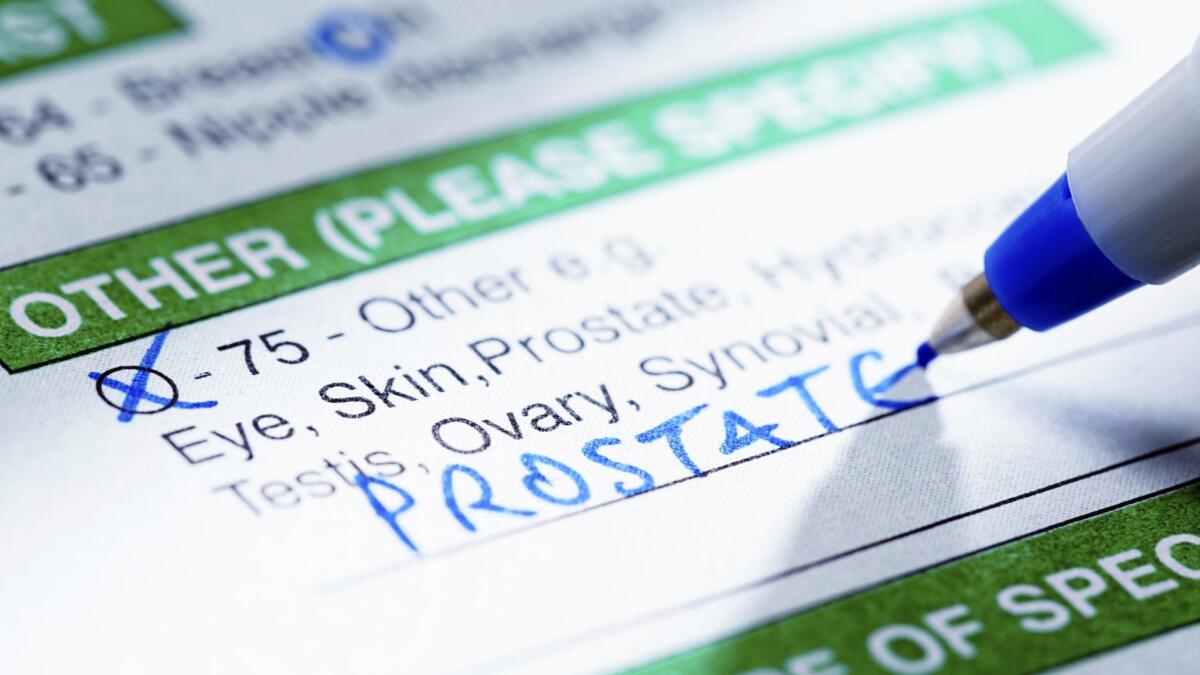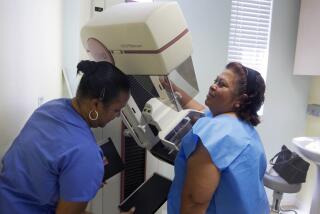Benefits of PSA test to screen for prostate cancer are roughly equal to its harms, expert panel says

- Share via
For men between the ages of 55 and 69, getting screened for prostate cancer is a mixed bag of possible, down-the-road benefits and just-as-possible immediate harms.
That means there’s no one-size-fits-all answer to the fraught question of whether to get screened for the most common type of cancer in men, according to new advice from a task force of preventive health experts. After weighing all the pros and cons with their doctors, the panel concluded Tuesday that some men may reasonably decide to take the test and others may just as reasonably opt to skip it.
For decades, prostate cancer screening was a routine part of healthcare for men of a certain age. A simple blood test would allow doctors to measure levels of a protein called prostate-specific antigen, or PSA. If those levels were deemed too high, it was considered a possible sign of cancer.
Over time, doctors began to realize that the PSA test wasn’t always a reliable indicator of cancer. They also saw that follow-up tests and treatments often caused serious problems.
The U.S. Preventive Services Task Force set out to determine whether the benefits of the PSA test could justify these risks. After examining the latest crop of studies published up through October 2016, the task force concluded that the answer would depend on whether a man placed a higher priority on avoiding prostate cancer or on avoiding unnecessary medical procedures that could affect his quality of life.
In its report, the task force advised doctors not to make the PSA test part of their standard exam for men ages 55 to 69. Instead, they should discuss the uncertainties about the test and order it only if their patients still want it, the panel said.
That’s a departure from guidance issued in 2012, when the task force recommended against using the PSA test in men of all ages.
The new report still advises against PSA testing for men ages 70 and older. In this age group, the panel said, the evidence is clear: Looking for prostate cancer and treating the tumors that are found would do more to erode quality of life than to extend it.
The task force was unable to come up with clear recommendations for the screening of African American men, who are more likely than white men to get prostate cancer and to die as a result.
Nor did the panel offer advice to men with a family history of the disease, who are about 30% more likely to be diagnosed than men with no first-degree relatives who had it.
Prostate cancer affects 101.6 out of every 100,000 men in the United States, according to the Centers for Disease Control and Prevention. In 2013, the most recent year for which statistics are available, 176,000 men were diagnosed with the disease and 28,000 died of it.
But screening for prostate cancer is fraught with uncertainty, and even a diagnosis usually raises more questions than it answers. Prostate cancer commonly takes hold in men who don’t suffer symptoms or ill health as a result: Among men in their 50s who died of other causes, autopsies revealed that more than 1 in 5 had prostate cancer. Among men who died in their 70s, more than a third had prostate cancer. Doctors often say that men are more likely to die with prostate cancer than of it.
Even upon diagnosis, the difference between an aggressive prostate cancer that could kill and one that might languish harmlessly for decades is often unclear to physicians. And aggressive treatment, which includes removal of the prostate gland or radiation treatment, impairs sexual functioning in more than half of men and frequently results in incontinence.
Not surprising, an increasing proportion of men — especially younger men and the roughly three-quarters judged to have “low-grade” tumors — are choosing “watchful monitoring” over immediate treatment.
Studies that followed men assigned to different treatment groups, including watchful waiting, suggest that 20% to 50% of men diagnosed with prostate cancer through screening might never have become ill.
If as many as half of prostate cancer diagnoses are cases of over-diagnosis, that makes the question of who should be screened — as well as how often and at what level of sensitivity — a consequential one.
“Unfortunately, no strategy completely eliminates over-diagnosis,” the task force wrote in its report. Some clinical research suggests strongly that more prostate cancer deaths could be averted if physicians used PSA thresholds that were lower than those widely used in the United States to diagnose prostate cancer. But preventing a small number of premature deaths would come at the expense of putting many, many more men through an unnecessary medical ordeal.
The panel’s roundup of rigorous clinical trial results suggests that over 10 to 15 years of regular screening with a PSA exam, a group of 1,000 men ages 55 to 69 years might lose one or two to prostate cancer. It may also prevent as many as three cases of prostate cancer that spread to other organs.
However, in that same group, 235 men will be recommended for a biopsy, which can cause infection, bleeding and pain. Of the 100 men who are ultimately diagnosed with prostate cancer, 80 will opt for surgery or radiation treatment, and 60 of them will suffer incontinence or impotence, the panel found.
If men in this age group choose to be screened, performing a PSA test every two to four years “appears to provide a good trade-off between a reduction in over-diagnosis and a small reduction in mortality benefit,” the task force said.
For men older than 70, prostate cancer screening didn’t offer any benefit, the panel said. For these men, hunting for prostate cancer risked pain, worry and expense without saving lives or even warding off metastasis.
The task force’s draft recommendation comes six months after it issued its findings in preliminary form. That initial report drew some controversy, including from screening advocates who urged that the panel’s report reflect stronger confidence in the lifesaving benefits of the PSA test.
Some of those critics asserted that screening should be credited for a decline in U.S. deaths due to prostate cancer mortality over the last two decades.
The task force responded that this trend started before the effects of widespread screening could have been detected. It added that many other factors, including better treatment, probably contributed to the decrease in prostate cancer deaths.
The draft recommendation will be open for public comment until May 8. When the panel’s final recommendation is issued, it will figure in insurers’ decisions about whether to cover the cost of PSA testing.
Although screening for cancers of the breast, cervix, lung, colon and rectum must be fully covered by health plans, the panel’s recommendations against routine PSA testing means that insurers may require co-payments to cover some of the cost.
ALSO
Your fitness tracker can count your steps, but it’s not that good at monitoring your heart
Speed up drug approvals at FDA? It’s already faster than Europe’s drug agency
Softball-sized spider species discovered in Baja California caves







